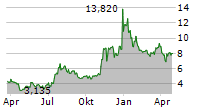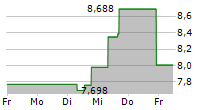
Blarcamesine: Potential novel oral treatment to target upstream Alzheimer's disease pathology through autophagy enhancement
Submission based on favorable ANAVEX®2-73-AD-004 trial results in patients with early Alzheimer's disease
Once daily oral administration of blarcamesine meaningfully slowed clinical decline in early Alzheimer's disease patients, demonstrating a favorable safety profile with no associated neuroimaging adverse events
NEW YORK, Dec. 23, 2024 (GLOBE NEWSWIRE) -- Anavex Life Sciences Corp. ("Anavex" or the "Company") (Nasdaq: AVXL), a clinical-stage biopharmaceutical company focused on developing innovative treatments for Alzheimer's disease, Parkinson's disease, schizophrenia, neurodevelopmental, neurodegenerative, and rare diseases, including Rett syndrome, and other central nervous system (CNS) disorders, today announced that the European Medicines Agency (EMA) has accepted for review the Marketing Authorization Application (MAA) for blarcamesine (ANAVEX®2-73), an investigational drug for the treatment of Alzheimer's disease. The Company is looking forward to working with the EMA.
Blarcamesine is an orally once daily administered small molecule for the potential treatment of patients with Alzheimer's disease.
"The EMA filing acceptance for blarcamesine to review the Marketing Authorization Application potentially brings us a step closer offering broader patient access to a new treatment option in Europe, and we look forward to continued engagement with the EMA," said Juan Carlos Lopez-Talavera, MD, PhD, Head of Research and Development of Anavex. "Through our clinical development program, we have seen that blarcamesine has the potential to slow the progression of this relentless and ultimately fatal disease."
The MAA is supported by data from the randomized, double-blind, placebo-controlled Phase IIb/III, ANAVEX®2-73-AD-004 trial and it's up to 144 week open-label-extension (OLE) ATTENTION-AD ANAVEX®2-73-AD-EP-004 trial investigating blarcamesine in early Alzheimer's disease. Former study was recently accepted in a peer-reviewed medical journal with focus on Alzheimer's disease titled, "Blarcamesine for the treatment of Early Alzheimer's Disease: Results from the ANAVEX2-73-AD-004 Phase IIB/III trial."
Strengthening the submission is the 265 week (~5-year) Phase 2a trial investigating blarcamesine in mild-to-moderate Alzheimer's disease, with interim preliminary data published in the peer-reviewed medical journal, Alzheimer's & Dementia, titled: "A precision medicine framework using artificial intelligence for the identification and confirmation of genomic biomarkers of response to an Alzheimer's disease therapy: Analysis of the blarcamesine (ANAVEX2-73) Phase 2a clinical study."
"We look forward to working with the EMA and thank the team at Anavex for their work on the submission," said Christopher U. Missling, PhD, President and Chief Executive Officer of Anavex. "We are committed to improving patient access to novel and accessible oral medicines."
Data from the Phase IIb/III trial demonstrated oral once daily blarcamesine pre-specified clinical efficacy through upstream SIGMAR1 activation. SIGMAR1 is an integral membrane protein which activates an upstream compensatory process: Blarcamesine induces autophagy through SIGMAR1 activation resulting in restoring cellular homeostasis.
Impaired autophagy precedes both amyloid beta and tau tangles, and therefore anticipates the neurodegenerative process in Alzheimer's disease.1 Hence, stabilization or restoration of autophagy can be seen as an early preventative measure countering the Alzheimer's disease pathology.
Blarcamesine, a small molecule administered orally once daily, demonstrated clinically meaningful improvement over 48 weeks with primary endpoint ADAS-Cog13 score being larger than 2 points.2 This suggests superior numerical clinical efficacy compared to approved therapies while also slowing neurodegeneration in early AD patients. Blarcamesine's safety profile indicates not requiring routine MRI monitoring, and given its differentiated mechanism of action, oral blarcamesine could represent a novel treatment that could be complementary or an alternative to injectable anti-beta amyloid monoclonal antibody drugs.
This release discusses investigational uses of an agent in development and is not intended to convey conclusions about efficacy or safety. There is no guarantee that any investigational uses of such product will successfully complete clinical development or gain health authority approval.
About Alzheimer's Disease
There are an estimated 7 million people in Europe with Alzheimer's disease, a number expected to double by 2030, according to the European Brain Council.3 The World Health Organization (WHO) estimated the cost in Europe of caring for people with dementia, including Alzheimer's disease, at $439 billion, or $31,144 per person in 2019. That includes hospital care, medicines, diagnostics, informal caregiver time, community services and long-term care facility costs.4,5
About Anavex Life Sciences Corp.
Anavex Life Sciences Corp. (Nasdaq: AVXL) is a publicly traded biopharmaceutical company dedicated to the development of novel therapeutics for the treatment of neurodegenerative, neurodevelopmental, and neuropsychiatric disorders, including Alzheimer's disease, Parkinson's disease, schizophrenia, Rett syndrome, and other central nervous system (CNS) diseases, pain, and various types of cancer. Anavex's lead drug candidate, ANAVEX®2-73 (blarcamesine), has successfully completed a Phase 2a and a Phase 2b/3 clinical trial for Alzheimer's disease, a Phase 2 proof-of-concept study in Parkinson's disease dementia, and both a Phase 2 and a Phase 3 study in adult patients and one Phase 2/3 study in pediatric patients with Rett syndrome. ANAVEX®2-73 is an orally available drug candidate designed to restore cellular homeostasis by targeting SIGMAR1 and muscarinic receptors. Preclinical studies demonstrated its potential to halt and/or reverse the course of Alzheimer's disease. ANAVEX®2-73 also exhibited anticonvulsant, anti-amnesic, neuroprotective, and anti-depressant properties in animal models, indicating its potential to treat additional CNS disorders, including epilepsy. The Michael J. Fox Foundation for Parkinson's Research previously awarded Anavex a research grant, which fully funded a preclinical study to develop ANAVEX®2-73 for the treatment of Parkinson's disease. We believe that ANAVEX®3-71, which targets SIGMAR1 and M1 muscarinic receptors, is a promising clinical stage drug candidate demonstrating disease-modifying activity against the major hallmarks of Alzheimer's disease in transgenic (3xTg-AD) mice, including cognitive deficits, amyloid, and tau pathologies. In preclinical trials, ANAVEX®3-71 has shown beneficial effects on mitochondrial dysfunction and neuroinflammation. Further information is available at www.anavex.com. You can also connect with the Company on Twitter, Facebook, Instagram, and LinkedIn.
Forward-Looking Statements
Statements in this press release that are not strictly historical in nature are forward-looking statements. These statements are only predictions based on current information and expectations and involve a number of risks and uncertainties. Actual events or results may differ materially from those projected in any of such statements due to various factors, including the risks set forth in the Company's most recent Annual Report on Form 10-K filed with the SEC. Readers are cautioned not to place undue reliance on these forward-looking statements, which speak only as of the date hereof. All forward-looking statements are qualified in their entirety by this cautionary statement and Anavex Life Sciences Corp. undertakes no obligation to revise or update this press release to reflect events or circumstances after the date hereof.
For Further Information:
Anavex Life Sciences Corp.
Research & Business Development
Toll-free: 1-844-689-3939
Email: info@anavex.com
Investors:
Andrew J. Barwicki
Investor Relations
Tel: 516-662-9461
Email: andrew@barwicki.com
1 Christ MG, Clement AM, Behl C. The Sigma-1 Receptor at the Crossroad of Proteostasis, Neurodegeneration, and Autophagy. Trends Neurosci. 2020 Feb;43(2):79-81; Chen, J., He, HJ., Ye, Q. et al. Defective Autophagy and Mitophagy in Alzheimer's Disease: Mechanisms and Translational Implications. Mol Neurobiol 58, 5289-5302 (2021).
2 Muir RT, Hill MD, Black SE, Smith EE. Minimal clinically important difference in Alzheimer's disease: Rapid review. Alzheimers Dement. 2024;20(5):3352-3363. doi:10.1002/alz.13770
3 https://www.braincouncil.eu/projects/rethinking-alzheimers-disease/
4 Jönsson L. The personal economic burden of dementia in Europe. Lancet Reg Health Eur. 2022 Jul 25;20:100472. doi: 10.1016/j.lanepe.2022.100472. PMID: 35910037; PMCID: PMC9326307.
5 World Health Organization (WHO); 2021. Global status report on the public health response to dementia.





